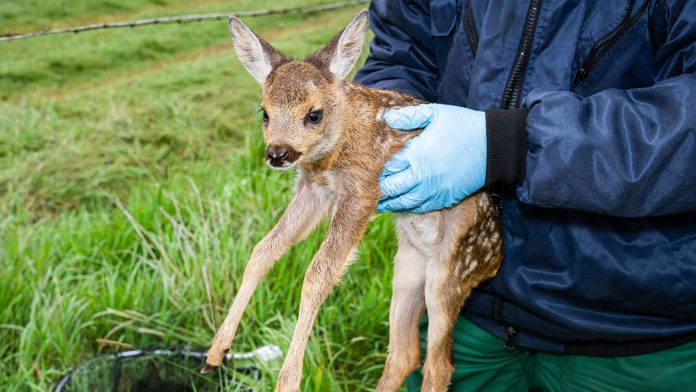Germany's hunters and wildlife conservationists are on the move again to save baby animals – with drones. This is the reason.
They circle over green rye fields and meadows shortly before dawn – drones equipped with thermal imaging cameras. They are operated on by Germany's hunters and wildlife rescuers. Your mission: to track down baby animals and their clutches and bring them to safety before they are mowed.
What sounds a bit like something out of a science fiction film is routine for drone pilots and farmers in Germany. Every year they work hand in hand during the breeding and planting season from mid-May to mid-June to ensure that young animals are not accidentally killed when mowing the fields with the sharp blades of the rotary mowers.
“Last year, the German Wildlife Rescue teams were able to save over 10,000 fawns,” explains Torsten Reinwald from the German Hunting Association (DJV) to t-online. “Animal protection is the greatest good for us hunters. Now that our nature is the purest nursery, we are particularly in demand,” says the biologist.
Unfortunately, thousands of young animals still die every year in collisions with machines. Often because farmers or tenants do not control their fields. Like most recently at Pentecost in the Upper Palatinate, where two dead fawns were found and the police are investigating violations of the Animal Welfare Act.
Why don't fawns escape?
Wild animals such as deer and hares prefer to hide their offspring from enemies such as foxes in the shelter of tall grasses and stalks of grain. “The parents keep an eye on their young from a distance, but only come by once or twice a day to nurse,” explains Reinwald.
And why don't they run away when they hear a mowing tractor? When danger approaches, young animals – unlike their adult counterparts – react with the so-called pushing instinct. Instead of fleeing, the animals remain motionless in their hiding place and press themselves to the ground. This method has proven effective against predators. However, in today's intensive agriculture, the hiding place quickly becomes a trap.
However, walking through a huge field and checking for young animals is virtually impossible. This is where drones have been coming into play for about five years.
This is how drone use works
Animal protection is mandatory for German farmers. They are required to search their fields before the first mowing. If they use drones and thermal imaging cameras, specialized hunters or animal rights activists arrive in the middle of the night to let their octopuses fly. Reinwald explains: “Because the drones are equipped with thermal imaging cameras, the operation must be carried out at dawn.”
Where a small, wild heart beats, it glows red and the wildlife conservationists just have to grab it. As little physical contact as possible is made. “The child animal is grabbed with gloves and placed in a box or laundry basket. When the meadow is mowed, we release it on the spot,” says Reinwald.
Although the method causes stress for a short period of time in young and parent animals, the procedure has no consequences. Because the animals quickly find each other again.
The effectiveness of drone searches has now progressed to such an extent that, in addition to deer fawns, young rabbits the size of tennis balls can also be found safely with a practiced pilot's eye. According to the German Wildlife Rescue Service, up to ten hectares of land can now be searched in an hour.


